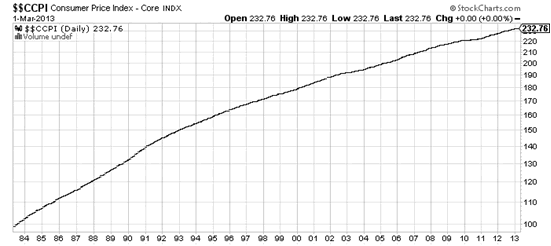How to Protect Your Portfolio from Inflation Without Gold
Stock-Markets / Inflation Apr 29, 2013 - 10:40 AM GMTBy: DailyGainsLetter
Moe Zulfiqar writes: Inflation is when the general price level increases. As a result, purchasing power diminishes; simply stated, every dollar buys less than it did before. Central banks around the world, including the Federal Reserve, continuously try to tame inflation so that it doesn’t get out of control, usually targeting for an inflation rate of anywhere from one to three percent.
One of the main causes of inflation is an increase in money supply. The reason behind this is very simple: as more currency is printed, its value diminishes; hence, more money is needed to buy things. For example, in the U.S., what $1.00 could buy you in the year 2000 now costs $1.35—inflation has increased 35% in just a matter of a few years. (Source: “CPI Inflation Calculator,” Bureau of Labor Statistics web site, last accessed April 24, 2013.)
Please look at the chart below of the Consumer Price Index (CPI), a measure used by the Bureau of Labor Statistics (BLS) to record inflation. The CPI has increased significantly over time.

Chart courtesy of www.StockCharts.com
The impacts of inflation are immense. While inflation affects the daily expenses of families, it can certainly take a toll on the portfolios of long-term investors as well.
Using the earlier example, just to maintain the same buying power, an investor’s portfolio must have earned 35% at the very minimum, or their portfolio would be at a loss.
To say the very least, a portfolio must beat the inflation rate for an investor to have at least the same buying power when it’s time to use their funds for whatever they were saving for, be it retirement, their child’s education, or traveling.
Keeping all this in mind, what should an investor do to at least beat the rate of inflation? Buy gold? Unfortunately, the recent plunge in gold prices has left some investors confused about its future and its ability to be a hedge against inflation, as it’s known to humankind—even when the fundamentals are still in place.
Another way investors can protect their portfolio against inflation is by buying Treasury Inflation-Protected Securities (TIPS). Simply stated, TIPS are similar to bonds—they’re marketable securities that can be bought or sold before maturity and whose performance is tied to the CPI. (Source: “TIPS In Depth,” TreasuryDirect web site, last accessed April 24, 2013.)
These kinds of securities behave just like a bond; the investor receives a monthly payment and, at maturity, a sum. But interest payments and the sum at maturity are based on inflation; if inflation goes up, the interest payment does too, and the amount the investor receives is higher, as well.
One of the biggest advantages of owning TIPS is that investors are exempt from state and local income taxes, meaning they only have to pay federal taxes. (Source: “Tax Advantages of Treasury Securities,” TreasuryDirect web site, last accessed April 24, 2013.)
Investors who are in the world of investing for the long term should definitely consider the affects of inflation on their portfolio. As the global economy is becoming a little fragile now, central banks are taking measures to cure it by printing money. This will eventually have consequences, and inflation may just be much higher than it looks in the future.
Source: http://www.dailygainsletter.com/wealth-manag...
Copyright © 2013 Daily Gains Letter – All Rights Reserved
Bio: The Daily Gains Letter provides independent and unbiased research. Our goal at the Daily Gains Letter is to provide our readership with personal wealth guidance, money management and investment strategies to help our readers make more money from their investments.
© 2005-2022 http://www.MarketOracle.co.uk - The Market Oracle is a FREE Daily Financial Markets Analysis & Forecasting online publication.



